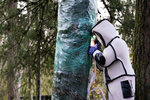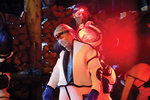




Philip Bovenkamp was the first to arrive. At 4 a.m. he pulled his lawn chair 100 feet behind the yellow caution tape on his neighbor’s east Blaine property. He drank black coffee in the 30-degree weather, and waited. It was eradication day.
“I didn’t know what to expect,” said Bovenkamp, whose reports of Asian giant hornet sightings late September catalyzed the first U.S. Asian giant hornet nest eradication on October 24. “I didn’t know if the hornets would be swarming around and mad, or tamed, but we decided to stay way, way back.”
A few neighbors trickling in became dozens as Washington State Department of Agriculture (WSDA) officials arrived around 5:30 a.m. to put on their eradication suits, thick enough to protect from the 6 millimeter stinger of the world’s largest hornet. Face shields also protected the entomologists’ eyes from spraying venom as the Blaine neighbors sat mere yards away, sipping coffee.
Before sunrise on October 24, these early risers would see four scientists vacuum 85 hornets from the first nest spotted in the U.S., located in a tree in a backyard off Burk Road. The nest was found October 22 after scientists successfully tracked one of four live hornets caught that week with a new, long-range radio tag.
Although the invasive hornets venom is no more toxic than a honeybee’s, the pests deliver multiple doses that can cause necrosis (the premature death of cells), WSDA managing entomologist Sven Spichiger said in a press conference the Monday following eradication. In Japan, the hornets are known to kill about 50 people per year.
This, paired with their ‘slaughter’ phase in fall, when a few hornets can decapitate around 30,000 honeybees, has dubbed them ‘murder hornet.’
International headlines spotlighted east Blaine in what many consider its biggest claim to fame. From trending on Twitter to news stories that read, “Murder hornets that will haunt your nightmares,” much of the U.S. has grappled with the idea of these killer hornets since they arrived in North America last year.
But neighbors said they didn’t find the hornets too murderous.
Over the last several weeks, the hornets have ingrained themselves in this community. Bovenkamp’s 14-year-old neighbor Childrey DeJong saw the large hornet with a distinctive orange head fly by her kitchen window the night of Bovenkamp’s first sighting. Even though it remained near her family’s new honey bee colony during WSDA’s second tracking attempt on October 7, they dismissed its presence after it appeared to ignore their hives. Around the same time, Matthew Furdyk, an 18-year-old Lynden senior, spotted a hornet on his family’s garden shed. The hornet, the size of his finger, made a deep humming noise as it pestered wasp nests but the teen said he was only concerned because of his mother’s bee allergies. He wasn’t about to change his daily routine.
Bovenkamp had been eyeing the nest before WSDA started its removal. He said he never felt in danger, and even took his 10-year-old daughter to visit the nest the day before. When he noticed the property owner inch toward the scientists’ eradication that morning, Bovenkamp and a dozen other neighbors felt safe to scoot their lawn chairs closer.
The eradication drew neighbors together who had been dealing with their separate experience of hornet sightings, Bovenkamp said.
“It was a community gathering,” he said. “We were sitting out there talking about the excitement of the week.”
WSDA staff planned their attack for when the most hornets would be inside the nest. The scientists stuffed the entrances of the nest, which was 10 feet high, with foam and wrapped the tree with cellophane. They then vacuumed the hornets from the one opening not blocked. To oust more hornets, scientists hit the tree with a board and then pumped carbon dioxide into the tree to kill the remaining hornets. Once the tree was sprayed again with foam and wrapped, scientists added traps for potential survivors or hornets that had been away from the nest.
Josie Shelton, whose 40-acre wooded property served as a launch zone on October 22 when scientists successfully tracked the hornet, likened the experience to the 1982 sci-fi film “E.T.”
Many who attended the eradication had followed the hornet with WSDA staff since the agency began knocking on their doors after Bovenkamp’s hornet sightings in late September. Shelton, Bovenkamp and a Discovery Channel film crew documenting their lives, followed WSDA entomologists to the nest on October 22.
Shelton described finding the nest as intense, as the scientists raced against the clock in late afternoon to beat the next day’s rain. Both recount the excitement of hearing Spichiger say, “there’s one, and another one” when he looked up and realized the nest was above ground, rather than underground, as scientists anticipated.
Following the nest detection going viral, neighbors say they’ve received calls from people they know from New York to Finland.
“2020 has been such a hard year, but this is something I think everyone can get behind,” Bovenkamp said. “It’s so good to have what I think is a feel-good story at the end of the day.”
But WSDA entomologists agree that while the eradication is a long-awaited victory, there’s still work to be done. And fast. The agency is working against the clock as the hornets are expected to start mating and creating new colonies by the end of October. Spichiger said there’s not a defining number for when the hornet population becomes unmanageable, but continues to warn about their destructive habit of decapitating pollinators.
Spichiger believes there is at least one nest in Birch Bay and possibly another in Custer and one in the city of Blaine. The agency has been stumped on leads to the suspected nests, especially the one in Birch Bay, where multiple hornets were found this summer but have since disappeared.
“While this is certainly a morale boost, this is only the start of our work to hopefully prevent the Asian giant hornet from gaining a foothold in the Pacific Northwest,” Spichiger said in an October 26 press release. “We suspect there may be more nests in Whatcom County.”
On October 28, the state agency cut down the dead tree with the nest, where it found two Asian giant hornet queens. It is not known at this time if they are two virgin queens or one virgin queen and one old queen, according to a WSDA tweet. Previously, no queens were found during the eradication. The state agency plans to excavate the east Blaine nest on October 29 by cutting down the dead tree.
Citizen scientists trapping will end October 31. The public has set over 1,500 traps since it started trapping in July. Whatcom, Skagit, Island and San Juan county residents can keep their traps through November, and should only submit their findings if they capture an Asian giant hornet.
Following the eradication, Josie Shelton walked along her wooded east Blaine property with her husband, Max, and 6-year-old daughter, Lily.
“I was nervous because at first they said it was a ground nest. We have five kids who run and play on the property, we didn’t know where it was,” Josie Shelton said. “If they didn’t eradicate it, we would be surrounded by murder hornets.”
Josie pointed to experimental traps WSDA hung on her property, along the path in which the hornets flew from their nest to the Bovenkamp’s property. The new traps contained the orange juice and rice cooking wine mixture, but also had water with a honeybee comb boiled in it and a lure with acetic acid and isobutanol designed to catch the pests before they hit their slaughter phase.
“I always thought that we were fortunate because we didn’t have any venomous critters,” Bovenkamp said, reflecting on the neighborhood’s experience with the deadly hornets. “Over time, we’ve gotten used to it and it’s just like anyone else who lives in an area with dangerous animals.”
Residents who’ve gotten near the hornets in the past few weeks echo similar sentiments.
“I felt like it was just any other hornet wasp or bee, unless if you’re out to get them, they’re not going to bother you,” said Stephanie DeJong, who watched the hornets fly in and out of their nest the day before eradication. “People were getting so freaked out about these killer murder hornets. They’re not something to be fearful of, they’re something to be aware of because we don’t want them in our area.”
Comments
No comments on this item Please log in to comment by clicking here